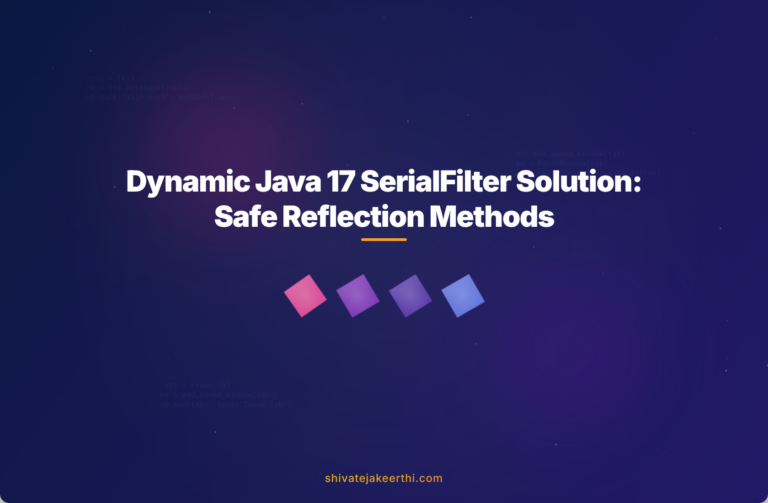If you’re maintaining Java applications compiled with Java 8 but running them in newer Java environments such as Java 17, you’ve likely faced headaches involving jdk.serialFilter compatibility issues. Java’s serialization filtering, controlled through jdk.serialFilter, evolved noticeably after Java 8, creating challenges in backward compatibility.
Failing to handle jdk.serialFilter correctly when upgrading from Java 8 to Java 17 can lead to partially or entirely unresponsive applications, security risks, or runtime exceptions. Let’s understand the core issue first.
Understanding the Java 8 Compilation and Java 17 Runtime Issue
Java serialization is widely used to transmit object data between Java applications or store a Java object’s state for later retrieval. However, serialization has historically posed certain security risks, primarily due to vulnerabilities surrounding object deserialization exploits.
To mitigate this, Java introduced the jdk.serialFilter in Java 9, providing developers a means to specify explicit rules governing permissible serialized objects. Java 8-compiled applications, however, might encounter runtime issues under Java 17 if they use approaches unsupported in newer Java versions. This mismatch is because Java 8 does not natively support methods available in later Java versions to set serialization filters.
When Java 9 was released, it introduced significant changes to serialization filtering, notably through the class ObjectInputFilter.Config. Applications strictly compiled against Java 8 might fail at runtime if they try directly using these APIs introduced post-Java 8.
Setting jdk.serialFilter in Java 8 Compiled Applications
In later Java versions, you’d typically call:
ObjectInputFilter.Config.setSerialFilter(yourFilter);
But this call leads to compilation issues if you’re restricted to Java 8, as the ObjectInputFilter.Config class simply doesn’t exist in Java 8. The class and its methods were introduced only from Java 9 onwards.
Ensuring Compatibility Across Java Versions
A resilient approach involves dynamically invoking the serialization filter setting at runtime using Java Reflection. Reflection allows you to check at runtime whether a particular class or method exists—and use it conditionally. That helps maintain compatibility between Java 8 compiles and Java 17 runtimes.
Here’s an effective step-by-step guide for setting jdk.serialFilter dynamically at runtime:
- Maintain your code compatibility by compiling it strictly against Java 8.
- At runtime, detect if serialization filter setting methods introduced after Java 8 are available.
- If available, apply your jdk.serialFilter dynamically.
- If these methods aren’t available (in pure Java 8 runtime, for example), your code avoids exceptions by gracefully skipping.
Implementing a Dynamic jdk.serialFilter in Your Application
The following Java method demonstrates a robust approach to dynamically load serialization filters:
private static void loadJavaSerializationFilter(String filterPattern) {
try {
Class configClass = Class.forName("java.io.ObjectInputFilter$Config");
Method setFilterMethod = configClass.getMethod("setSerialFilter",
Class.forName("java.io.ObjectInputFilter"));
Method createFilterMethod = configClass.getMethod("createFilter", String.class);
Object filter = createFilterMethod.invoke(null, filterPattern);
setFilterMethod.invoke(null, filter);
System.out.println("jdk.serialFilter successfully applied.");
} catch (ClassNotFoundException e) {
System.out.println("Running on Java 8. No serialization filter support.");
} catch (Exception e) {
throw new RuntimeException("Unable to set jdk.serialFilter: " + e.getMessage(), e);
}
}
Let’s briefly unpack what’s happening here:
- Reflection Approach: We’re looking up the
ObjectInputFilter.Configclass dynamically at runtime. - If found (Java 9 or newer), we retrieve the appropriate methods (
setSerialFilter()andcreateFilter()) needed to establish serialization filters. - If not found, we gracefully skip the operation, printing a message and ensuring your code remains stable in a Java 8 runtime environment.
Testing Your Implementation Across Versions
Testing your code’s serialization filter compatibility across Java versions is critical. Here’s how you can ensure reliable results:
- Version-Based Testing: Run your application across different Java runtime versions (Java 8, Java 11, and Java 17) to verify expected behavior.
- Integration Testing: Introduce automated integration tests to quickly identify any breaks or inconsistencies during runtime. Test dynamically set serialization filters thoroughly with various input patterns.
- Troubleshooting Common Issues: Check logs for specific informative messages like “jdk.serialFilter successfully applied” or “No serialization filter support”, and verify your application’s security state using tools recommended by OWASP best practices.
If you encounter common issues related to serialization security, referencing sites like Stack Overflow or Oracle’s official Java documentation (java.io package documentation) can help guide your debugging efforts.
Best Practices for jdk.serialFilter Maintenance
Serialization filter management should be an ongoing responsibility. To keep your applications secure and maintainable, follow these simple but effective best practices:
- Stay Updated: Regularly update your serialization filters to reflect new security advisories and exploit research information. Set calendar reminders or leverage your Continuous Integration/Continuous Delivery (CI/CD) pipeline to periodically review your configurations.
- Version-Control Your Filters: Keep the filter patterns externally configurable and under version control (like Git). Storing and tracking changes helps avoid unexpected serialization-related issues during deployments.
- Careful Whitelisting: Always use restrictive filter patterns instead of “allow all” approaches. Only whitelist object types needed by the application explicitly. Refer to reputable sources like the official Java Security documentation for insights and best practices.
Final Recommendations on jdk.serialFilter Compatibility
Addressing serialization filter compatibility is crucial for secured and reliable Java-based apps. By dynamically setting your jdk.serialFilter using reflection, you’re positioning your Java 8-compiled applications for seamless and secure operation within modern Java performance environments, including Java 17.
Treating serialization filter configuration proactively also safeguards your Java applications against prospective deserialization vulnerabilities. Ultimately, maintaining this compatibility not only enhances your application’s robustness — it also saves considerable time spent troubleshooting Java compatibility errors.
What strategies have worked best in your experience handling Java version upgrades? Share your insights or questions with fellow Java developers below or explore our other topics in JavaScript development resources for additional learning!



0 Comments